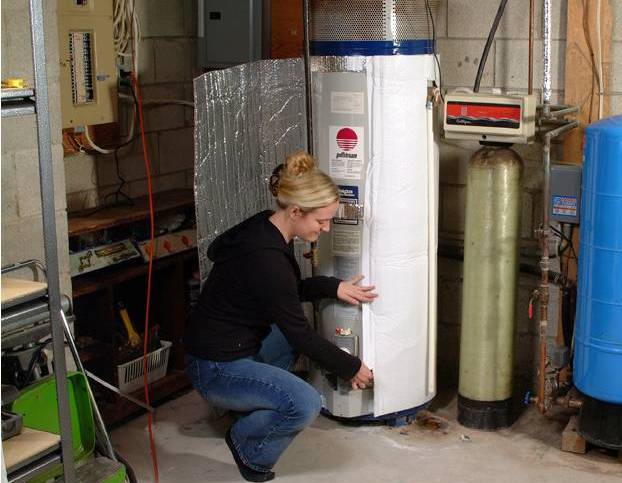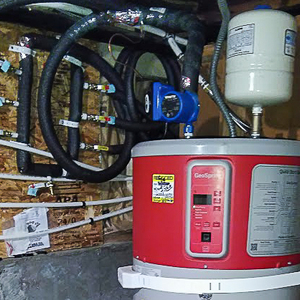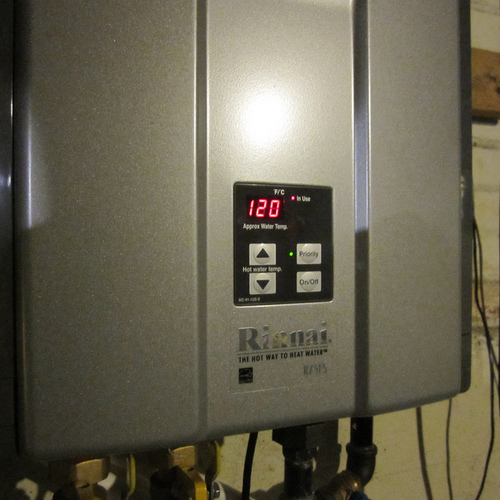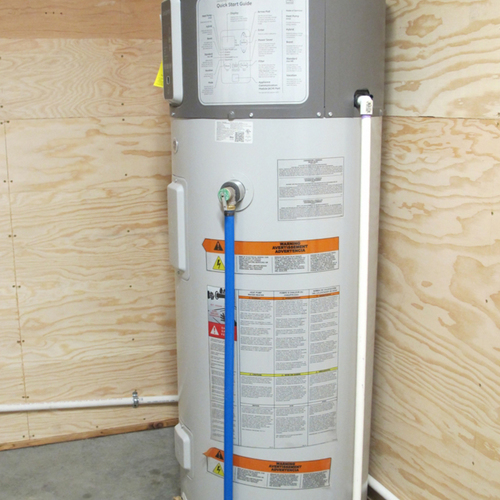
Image Credit: www.buyfoilinsulation.com
Last week I wrote about a high-tech solution for water heating–heat-pump water heaters that can cut costs by more than half compared to conventional electric water heating. This week, I’ll address the low-tech efficiency side of water heating.
First, some context: in a typical American home, according to the U.S. Department of Energy, water heating accounts for about 16% of total annual energy expenditures–a little more than for air conditioning, on a national-average basis, and twice as much as is used for refrigerators. An average American family pumps nearly 3,000 pounds of carbon dioxide into the atmosphere each year from heating water, a not-insignificant contributor to global warming.
The two easiest ways to reduce your energy use for hot water are to a) use less hot water, and b) reduce heat loss in your water heating and hot water distribution systems. We’ll take a look at each of these in turn.
Reducing hot water use:
-
Replace older showerheads with new, low-flow models. Expect to spend about $25 for a good model that delivers a satisfactory shower with as little as 1.6 gallons per minute.
- Fix any leaking faucets or showerheads.
- Replace aerators on bathroom faucets with products that have a flow rate of no more than one gallon per minute.
- Wash laundry in cold water, or at least use a cold-water rinse.
-
If you’re replacing your clothes washer, buy an Energy Star, horizontal-axis (front-loading) model.
- Reduce waste in washing dishes. Most modern dishwashers don’t require that dishes be rinsed; just scrape off food. If you must rinse, use cold water.
- If you’re replacing a dishwasher, buy an Energy Star model.
Reducing waste in heating and distributing hot water:
-
Insulate your water heater. If you have a storage-type water heater, adding additional insulation will reduce heat loss from it. Follow manufacturer’s recommendations on insulation, especially with gas-fired water heaters (to avoid blocking the air inlet).
- Insulate hot water pipes. If the water sitting in your hot water pipes stays warm after you run the tap, there’s greater likelihood that you won’t waste water and energy the next time you turn on the hot water. In new construction, all hot water pipes should be insulated (I even recommend insulting cold-water pipes to reduce condensation and dripping in the summer). In existing houses, insulating pipes can be quite difficult and may not be worth the effort, except for those that are readily accessible–such as in a basement.
- Install “heat traps” or “anti-convection valves” on the hot and cold water connections to your water heater. These simple devices prevent “thermosiphoning” of heat out of the water heater.
Some new water heaters include built-in heat traps.
- Turn down the temperature setting on your water heater. If your water heater is currently set to 140 degrees F, decreasing it to 120 degrees (about midway between the “medium” and “low” setting on most water heaters) should reduce your energy use for water heating by 6-10 percent. Due to concern about Legionella bacteria, which can live in lukewarm water, some people recommend keeping a water heater set to at least 130 degrees.
- Install an “on-demand circulator” under bathroom or kitchen sinks that are located far from the water heater. This is a user-activated pump that brings hot water to the point-of-use and returns water that’s been sitting in the hot water pipe back to the water heater. See my Energy Solutions column, “Waiting for Hot Water,” from June, 2009 for more on this strategy.
Once you’ve invested effort in reducing hot water use and minimizing losses in your water heating system, an alternative system–such as a solar water heater–will be able to satisfy a larger fraction of your needs and can be kept smaller (and more affordable). “Efficiency first” is almost always the best investment.
I invite you to share your comments on this blog. You can also follow my musings on Twitter.
Weekly Newsletter
Get building science and energy efficiency advice, plus special offers, in your inbox.















6 Comments
Setback timers for hot water heaters
What about setback timers/thermostats for water heaters? Peak times for water usage are often early morning and the evenings; some usage during the day and almost none at night. What range of savings can be expected? Who makes 7 day setback thermostats for gas water heaters and how much do they cost for a 12-20 unit condo?
Water Heating savings with an insulation blanket
Standard water heaters today are equipped with the medium quality insulating foam, which is around the value of R-10. High efficient water heaters have the thicker foam of 2-3" but still below the R value when it is recommended to use the insulation blanket (R24).
By adding an insulation blanket to the conventional type water heaters (unless its R value is 24 or above), one can reduce the standby heat loss by 25-45% and water heating cost from 4-9%.
Insulation blanket is available for the price of 10-20$... and even higher for the best ones. Choose the pre-cut foam with the high R insulation value.
Also, recommendation is to insulate the first 6 feet of the hot and cold water pipes connected to the unit. Some manufacturers will include with the water heater foam tubes for the pipe insulation. Apply insulation on the water pipes if the piping goes through the unheated area or the pipe is warm to the touch (for hot water pipes).
Resources: http://www.hot-water-heaters-reviews.com/water-tank-heaters.html
Lots to find wrong with this article
Not sure where to start ... Maybe horizontal axis washers: I bought one and did some tests. First I read Consumer Reports and choose a highly rated one, efficiency-wise. Then, before I removed the old one I washed 3 bath towels and 3 hand towels. After the final spin I weighed them. Then I did the same test again. Results were very close. Then I removed my old top-loader and installed the new front loader and did the same tests with the exact same towels. The differences were within 1 ounce. I was shocked. The old Kenmore top-loader has seen better days ... it's O-L-D and it did as well as the brand new fancy-pants magic front loader. Humpf. So much for advertising. I have access to another newer (but still old) top loader. Re-ran the tests. This top loader (Whirlpool Energy Star) was consistently a couple of ounces better than the front loader. Save your money. Those new front-loaders are bloody expensive. Note: I returned the new washer for my money back.
Insulation blankets? Not if your water heater is newer. The new foam insulation is good enuf that it won't help that much. And it's the BOTTOM of the heater that they didn't used to put any insulation into. So if it sits on a cold concrete floor .... well, you know. You got nice toasty concrete down there for whatever that's worth.
Insulate your pipes? DOE research shows that the most you can gain is about an hour. If it sits for more than hour you're not winning. Also, use the expensive neoprene insulation over the cheap foam stuff. And if you know your Delta-T physics you know that you MUST (absolutely must) get every cubic millimeter of the piping covered or it's basically a waste. And those nice big pipe hangers made out of metal ... you think they don't conduct heat and radiate it outside the insulation? Think again.
I could go on.... but here's one of the most important discoveries: It's been clearly shown that when the average user goes for hot water ... that 92% of the time THEY NEVER GET ANY HOT WATER. How is this, you ask? Because they (you) shut the spigot off before it gets there! 92% of the time. Watch yourself for the next few days .... you'll see. Go to wash your hands, go for the hot, lather up, rinse, shut off. No hot water. You filled the pipes and now they can get busy dispersing that heat in the walls or the basement, but you never got any. Lots of times, every day.
Another thing. How big are the pipes that carry that water? Did you go for the macho, he-man 3/4" stuff? You know, to be sure you get WATER when you want it. Now go check the last foot of piping under the sink. ( !! ) Quarter inch is it???? Do you know how water flows and pipes sizes and ...... ?? If you have 3/4" you're probably only getting hot water less than 5% of the time. If not, you're sure wasting a lot of water just to get it warm. Even 1/2" can be considered bigger than necessary. How much water does the piping hold when it's 3/4" vs 3/8"? Hint: If you know your geometry it's a heck of lot more than double!
There's lots more. This article has so many holes in it, it leaks like a sieve. You can do better GBA.
Response to Dirk Faegre
Dick,
Thanks for your comments, which are pertinent and helpful.
You wrote, "You can do better, GBA." If you read more articles on our site, you might be surprised.
For example, you should check out the article on Efficient supply layouts in the GBA Encyclopedia. The article notes, "A 3/4-in. dia. supply line in a trunk-and-branch system holds a lot of water. When a hot-water tap is opened in a bathroom far from the water heater, all the water sitting in the 3/4-in. pipe must flow through the system before any hot water reaches the user. In a home-run system, the tubing is usually only 3/8 in. or ½ in., so less water is wasted before hot water reaches the faucet."
GBA has many other articles about some of the issues you have raised; the "Search" function on each page will help you find them.
Additional response to Dick Faegre
Dick,
Your diatribe against my article is quite surprising.
Your claim that horizontal-axis washers don't really save energy seems to be based solely on moisture removal during the spin cycle (resulting in less drying energy). Your study doesn't sound very thorough, but even if it's correct the primary way most H-axis washers save energy is by using less hot water--though if you wash in cold water (as the article suggested), that would not be an issue.
As for insulating storage-type water heaters, I should have noted that this is more important with older water heaters--which is what most people have.
As for the issue of wasting water and energy waiting for hot water to reach the tap, my article mentioned on-demand recirculation systems, which solve that problem. GBA has lots of information on these systems. The statistic you quote is interesting, but it only supports the argument I made for on-demand recirculators. I am well aware of the issue with larger supply pipes worsening the problem; my articles and others in GBA have addressed that point in detail. I should have linked to some of those articles.
Regarding my recommendation to insulate hot water pipes, your points are well-taken, but the article pointed out how insulated pipes can reduce hot water use--because there is a greater likelihood that you won't have to wait for hot water when turning on the tap within a hour of the previous use--the savings here are all about usage patterns. Savings in most homes will be minimal, but it it's easy to insulate the hot water pipes, I still recommend doing so.
Effectiveness of Tank and Pipe Insulation
I did a study on a home in Boone, NC with the 40gall water heater and all the water pipes in an unconditioned basement. We tested the energy usage of the water heater over a 6 day period when no one was home, so no water use period. It was winter, so the basement was around 45F. The first two days we logged baseline energy use. Then we wrapped the tank with a standard blanket from Lowe's and logged for two days. Then we insulated the top of the tank (it was an electric water heater), all hot water pipes, and the first 6 feet of cold water pipes and logged for two days.
The tank blanket cut energy use by 21 percent. Insulating the pipes and the top of the tank cut energy use by another 8 percent. Remember that this represents standby losses only, since there was no water use during the test period. I can't say exactly how much of this 8 percent was from the top of tank insulation, but according to the thermal images, that area is a major point of heat loss. I would wager that insulating the pipes (outside of the first six feet from the tank) did not save much energy at all. That said, I still do it, but then I also use reusable grocery bags and turn off the water while I soap up in the shower. Something I think everyone should do, but probably won't catch on anytime soon.
Log in or create an account to post a comment.
Sign up Log in